
The haters. Oh boy, the haters. If the internet has taught us one thing, it’s that people sure love to dump on stuff. For anyone who spends any time online, they’ll find that the trash talk between brand-loyal watercraft enthusiasts is roiling at a fever pitch. Barbs are freely exchanged, but when it comes to Sea-Doo, one jab rears its ugly head more than any other: they sink. And if you were to believe what the digital mob preaches, it happens all the time.
So if we are to believe that these machines sink more often than a lead-filled, mesh-bottomed canoe, why is it that Sea-Doo has the largest slice of the marketplace; or some of the highest customer satisfaction; or the largest segment of returning customers than any other brand? Could it be the haters are wrong? *gasp!* Well, we won’t say “wrong”, but we will say that there is a lot of misinformation floating out there, and quite a bit that’s simply missing from the public dialogue.

Now that we’ve got you all roiled up and triggered, let’s dive into the meat of the story. In this essay, we’re going to address the primary cause of most of these rumors, these uniquely rare and isolated experiences, and more importantly, how to make sure it never happens to you.
The subject in question is Sea-Doo’s carbon ring. This ring encircles the driveshaft prior to it exiting through the hull and into the pump, sealing the hull from the water outside. The two-piece design provides the craft a waterproof seal while allowing the shaft to spin with the least resistance (ie. friction) possible. More pertinent to the focus of this discussion, the carbon ring is a wear item, just like the wear ring in the pump. It is not designed to last forever.

When under optimal conditions (correctly installed, operated and serviced), a carbon ring can last upwards to 100-to-150 operating hours. Yet, we find more often than not, premature failure of the carbon ring directly linked to operator error, misuse and damaged equipment. Thankfully, there are several telltale signs to alert a Sea-Doo owner well before a catastrophic failure – that is, between the watercraft’s regular service intervals.
The first cause for potential carbon ring failure is also the most common – and gratefully, the easiest to avoid: excessive heat. While not in direct contact to the driveshaft, the carbon ring caps the bellows (the corrugated black rubber boot that contains the shaft’s ball bearing) that encloses the shaft. The carbon ring is preloaded against a tapered, machined support ring (ie. hat), which is held in place on the shaft by a keyed circlip. It’s the carbon ring pressing against the hat on the driveshaft that makes the watertight seal.
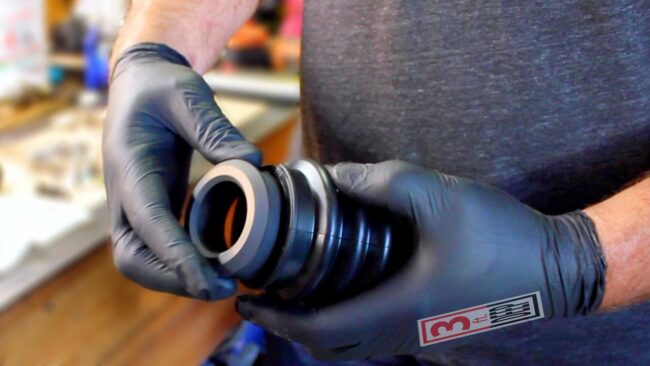
As the driveshaft spins, so does the hat – with its flat machined surface – pressed against the stationary carbon ring. This of course, generates friction. Friction causes heat, and excessive heat often leads to early failure. The carbon ring is only cooled when the Sea-Doo is in the water – whether idling or at speed. The heat generated by the hat’s surface spinning against the face of the carbon ring can lead to premature wear (and failure) when operated too long out of the water.
Sounds pretty simple, right? Well, not so when you see folks revving the snot out of their Sea-Doo on the trailer. Even when flushing the exhaust system with a running hose, the carbon ring is not being cooled. That is why the operation and service manual recommend running the engine no more than 90-seconds out of the water. Even “blipping” the throttle hard enough to purge the waterbox can lead to premature wear and failure.

While a bent or injured impeller blade can cause undue and aggravating turbulence, the unsettling harmonic is more likely to radically deplete the longevity of the pump’s wear ring before injuring the carbon ring – primarily because the carbon ring is only making contact with the hat, and not the shaft itself. Yet, a bent driveshaft oscillating at several thousand revolutions per minute can carve an erratic wear pattern into the carbon ring’s face, eventually leading to an early failure – although this is often the least likeliest cause.
Although not common, bending or distorting a driveshaft can happen due to careless operation; either by sucking up a tightly coiling a rope; or impact with rocks, branches or other objects small enough to pass through the intake grate. Even when poorly maintained or with parts improperly installed it is difficult to damage a driveshaft enough to injure the carbon ring.

The final factor linked to carbon ring failure is often its hardest to diagnose; engine misalignment. First and foremost, it is incredibly rare that an engine come from the factory misaligned; and all damages would be rightly covered by BRP’s warranty. Rather, it is more likely that engine misalignment is the byproduct of either harsh impacts from wave jumping or having had the engine out before.
Contrary to popular belief, these high-powered machines are not designed to jump waves, and doing so rapidly weakens, loosens and often breaks engine mounts. During a particularly severe impact, the driveline undergoes extraordinary torsional forces, causing the engine to literally shift. It might be significant (in the form of a broken motor mount) or minor, but a misalignment has potentially occurred.
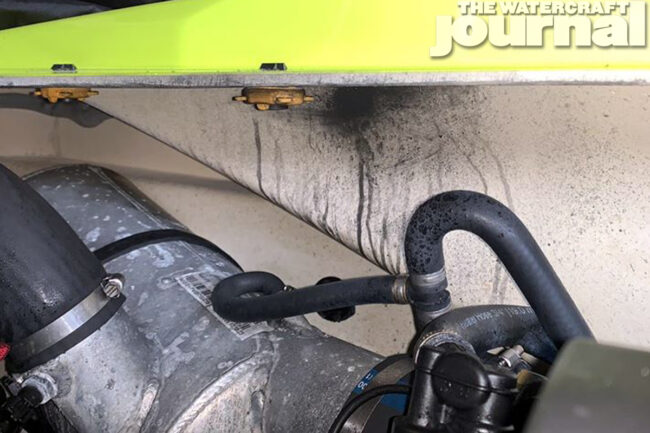
Many times, such riders have replaced broken or worn motor mounts presuming that aligning the bolt holes would return the driveline to its proper default position. Not so! Certified BRP mechanics will have the correct alignment tools to ensure that the driveline is square. The same goes for the aftermarket tuner or the less-than-reputable repair shop who misaligned the engine upon reinstalling it. Both of which, the onus lies with the owner, not BRP.
Because the carbon ring is the final line between having a great day out on the lake or sinking to its bottom, it’s best to 1. maintain a proper service inspection schedule with your dealer or certified mechanic; 2. look for signs of wear in the form of excessive water in the engine compartment (particularly around the bellow), water whipping violently around the bellow, or large deposits of fine dark gray carbon blown or streaked across the engine compartment; and 3. to consider upgrading your carbon ring kit.

The Watercraft Journal spoke with Greenhulk PWC Performance‘s own Jerry Gaddis, who recommended upgrading to the new style carbon ring hat. Jerry explained, “The new carbon seal hat is 5mm thicker. That means its putting more tension on the carbon ring for a better seal. The kit is less than $90 bucks and comes with the new thicker hat and a brand new carbon seal. It’s the cheapest insurance policy you can get.”
So no, Sea-Doo’s don’t sink; but poorly maintained or incorrectly operated Sea-Doos with worn out carbon rings can though. Proper use and regular service from certified technicians will ensure your Sea-Doo will continue to perform as the day you first picked it up from the dealership; it’s really that simple. And for the haters online? There’s not much you can do about those miserable saps but sit back and feel sorry that they’re not having as much fun as you are.
Addendum (8.24.20): There have been a rash of carbon ring seal failures in recent years as noted by increased service requests. According to The Watercraft Journal’s sources, a confluence of weak or porous materials used by outside suppliers and a limited sequence of units manufactured with slight engine misalignment have contributed to premature failure of carbon ring seals. To our knowledge, 2020-and-up models are not showing these failings. Regardless, please take added precautions to operate your Sea-Doo within the prescribed guidelines outlined in your operator’s manual, as well as stay “on top” of your regular service schedule.
Additional photography and the video below via 3ft Deep.








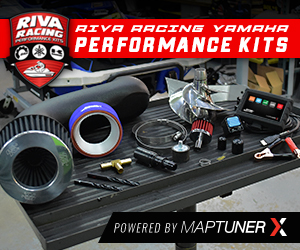

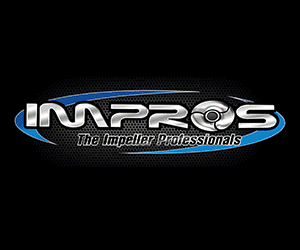



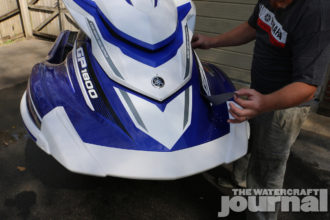
No, it’s not.
The top cover picture was provided to WCJ by a contributor, and wasn’t meant as an installation tutorial.
[…] According to Watercraft Journal, if a Sea-Doo gets the necessary care and attention, it will be as reliable as any other models on the market. […]
How does one easily/routinely check this? On my 2019 GTX there are 13 bolts holding the engine cover in place. of course these need to be tight and secure to hold the seats in place, but if this is something to be checked routinely, could there be an easier to access design?
No. Because BRP wants you to bring you watercraft in to a certified dealer and have them service it. This is the same reason why Mercedes-Benz started “sealing” its transmissions, removing dipsticks and generally forcing owners to take their cars in instead of servicing it yourself.
I completely agree That this is all on seadoo. My buddy’s 300 just almost sank over the weekend cause the cir-clip popped off and the support ring slid forward. I also work as an engineer in the machinery industry and if someone wants to work with me in designing a solution to this I could easily manufacture some prototypes myself and maybe put something on the market if it proves itself. Obviously seadoo isn’t interested in solving the issue so lets just do it ourselves. If anybody is interested in working on this reply and lets get in contact.
Anthony… I agree ! And I think the engineers at MerCruiser have already done most of the work for us … If you reference the a-typical IO design on boats, they use a shaft bellows with a sealed bearing instead of this arcane carbon business. Example, take a look at the bearing in this “Sierra MerCruiser Alpha 1 Gen 2 Transom Bellows Repair/Reseal Kit 30-803099T1 18-8218”. Basically, this design uses a uniquely sealed “bearing”. The inner race spins with the shaft, and the outer race is stationary, being clamped to the bellows. This bearing does not provide any structural support (in the way most bearing implementation provide) … Rather, it simply acts as a sealed component between the inner and outer races. Therefore, this one bearing could conceivably replace both the carbon ring and the cap (hat), if you found one that matched the OD of the Sea Doo shaft. That said, you would need to still address some sort of o-ring concept for the inner race – since you will loose the o-rings in the now missing cap. The only other reservation I have, is total RPM tolerance, as Sea Doo shafts are expected to spin twice as fast as the a-typical IO. You can catch me on the GreenHulk forums.
Is sea doo the only one using this system? Im thinking of getting a kawi
I operate a rental company and have run 2011/12 Seadoo GTS’ 130 for ten years. I have over 1300 hours on each of them and have never replaced a carbon ring. They are very well designed. The current upgrade kit utilizes a large diameter metal sealing washer and a larger I.D. on the ring. The odd pwc ends up with the engine and driveshaft sitting higher up and wearing the inside of the ring a bit – you can rotate the ring every so often if you wish.
They key to long life – water and deeper water acceleration. When doing an exhaust flush or running on land, spray some water up the grate towards the ring before and after. When operating your pwc, don’t do the Baywatch “ramp it up the beach to park” and start the engine in waste deep water and idle out to a 6′ mark before accelerating – no sand no problem. This also helps the wear rings in the jet pump too. I have only replaced those when rocks have gouged them out, but never from general operation. If you keep the carbon ring wet, it will last forever – almost. 100 – 150 hours? That’s carelessness and a lack of knowledge on the part of the operator.
You have a greater likelihood of sinking a seadoo from broken reverse and steering cable retaining nuts than the carbon ring.
Some lakes have inspection before you can leave and require multiple full throttle blips to clean out the water box. Really ticks me off.
My SeaDoo Rocks wanna race.People Tripping
2021 fishpro maiden voyage 50 minutes followed by 12 hours tied at slip with cover. Next morning 16” water in engine compartment up to the front storage trunk 4” water in there supposedly that’s the new carbon ring. Of course they shipped it six months late with the defective IDF so the stealership had to remove the shaft to repair the IDF ( which btw is totally redesigned for 2022 but you won’t learn that here or from seadoo or from your stealership because they’re all crooks) so stealership may have botched the repair that should have been made at factory. In fact since they already had the new design ready in March that should have gone in not the shitty upgrade kit to the old design.
Seadoo and everyone connected with them are crooks maybe the other companies are no better don’t know I stupidly chose seadoo!
This writer always dismisses every legitimate warning about seadoos ethical and engineering deficiencies with this it’s other manufacturers fanboys or internet trolls. Then months later when it’s no longer deniable he admits and minimizes all over again obviously his loyalty is to manufacturers not readers
Sorry to hear about your Fish Pro, but there’s more to the story that you should be made aware of: Sea-Doo has a very poor record when it comes to the first year of any technology; be it iBR, iTC, CM-Tech or IDF (just in the past decade or so). Buyers should be prepared to do their own due diligence, including researching complaints, recalls and repair requests. Does this statement blame you for buying one? No, not at all. But I am stating all of the facts.
Second, the first 6 months of IDF-equipped Sea-Doos struggled with multiple failures. Thankfully, most IDF failures occurred within the first 2-5 hours of operation, which alerted BRP engineers early in the season. It took until June for the full 6-part parts replacement solution to be finalized. All production units after this time as well as all repaired units with this final fix have seen minimal (fractions of a percentage) failures. Repairs prior to this fix were bandaids, sadly and did not fully resolve the issue.
Sea-Doo’s carbon seal saw major improvements in 2020. Changes to the driveshaft, bellows and circlip in 2021 resulted in dramatically less carbon seal failures. The lowest in 14 years. This article directly addresses how users are culpable for damaging the carbon seal, causing premature wear and/or complete failure. YES! The user can damage the carbon seal because on Sea-Doos carbon seals are still the weakest link in the vehicle’s design. I and our team have exhausted these cautions but far too many choose to ignore these warnings and damage their carbon seals.
Vlad, trying to ascribe my loyalties to the manufacturer vs. the readers is pathetic on your end. I am screaming “DONT DO THESE THINGS OR YOU’LL SINK YOUR SEA-DOO” and people choose to ignore these cautions and beach, shallow start, jump, operate out of the water, etc. their Sea-Doos and then cry incessantly when the carbon seal fails. Is it a bad design? You bet. Should Sea-Doo follow Yamaha and Kawasaki and get a sealed bearing? 100%. Will they? Not a chance.
So yeah, you bought a Sea-Doo. Now you need baby that carbon seal for as long as you own it. You made that choice, so live with it.
Thanks for the article Kevin. owning a seadoo is like having a hot gf…a pain in the ass but worth it.
“the first 6 months of IDF-equipped Sea-Doos struggled with multiple failures. Thankfully, most IDF failures occurred within the first 2-5 hours of operation”
this would seem like poor testing procedures to me….as usually with seadoo
I blame Yamaha. Yamaha has failed to innovate like Seadoo has, and lags far behind in features, ride comfort, ergonomics, aesthetics, etc. so customers like me are force to buy seadoo year after year. i wish yamaha made a ski worth me buying, so i could get that nice 4 cylinder engine and have easier maintenace.
that being said. Ive been riding seadoos for 22 years. ive only been stranded once. also ive learned a lot from the forums and have completely bullet-proofed my current seadoo. i dont have any problems and i get the enjoy all the perks of having a seadoo.
-Phil
Well, my Seadoo, a 2009 GTX 155 SUNK last week due to this defect. 124 hours on the ski, and it’s trash. It was last serviced by a SeaDoo authorized shop in March. Insurance company is NOT covering itbecause it’s a “maintenance issue”. Thanks SeaDoo. I’m out $7000.